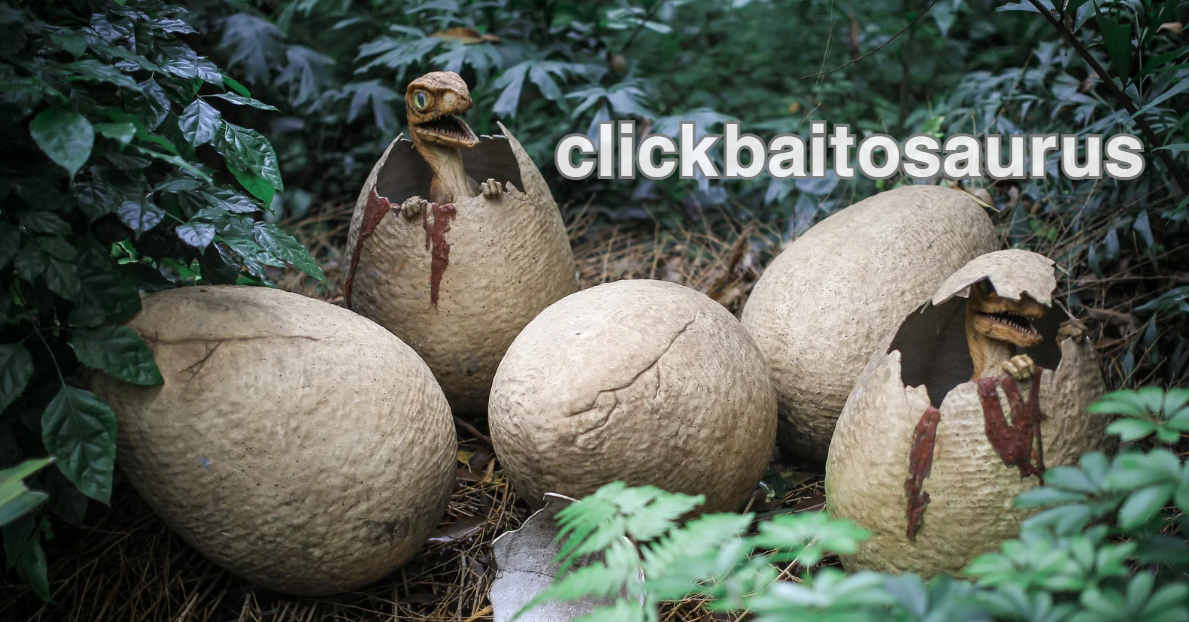Contents
Introduction
In the digital age, where attention spans are shrinking and competition for visibility is fierce, the term “Clickbaitosaurus” has emerged as a compelling metaphor for the modern phenomena of clickbait. This article delves into the intricate world of clickbait, exploring its psychological underpinnings, marketing strategies, and societal impacts. We’ll dissect the evolution of clickbait, its effectiveness in engaging users, and the ethical considerations surrounding its use.
What is Clickbait?
Definition and Origins
Clickbait refers to sensationalized or misleading content designed to attract clicks and views, often with exaggerated headlines or provocative images. The term is derived from combining “click” and “bait,” reflecting the bait-and-switch technique used to lure readers into clicking on a link.
The concept of clickbait is not new. Historically, sensationalism has been a part of media to capture attention. However, with the rise of the internet and social media, clickbait has become more prevalent and sophisticated, evolving into a major aspect of digital marketing.
Examples of Clickbait
- Headlines: “You Won’t Believe What Happened Next!” or “This One Trick Will Change Your Life Forever!”
- Images: Eye-catching, provocative, or emotionally charged images that are often not directly related to the content.
- Content: Articles or videos that promise more than they deliver, often providing superficial or unrelated information.
The Clickbaitosaurus Metaphor
Understanding the Metaphor
The Clickbaitosaurus metaphor serves to illustrate the overwhelming and often deceptive nature of clickbait in the digital landscape. Just as a dinosaur might loom large and dominate its environment, clickbait pervades online content, influencing how information is consumed and perceived.
The Evolution of Clickbait
The evolution of clickbait can be likened to the evolution of the Clickbaitosaurus. Initially, clickbait tactics were simple and obvious, but as digital platforms and algorithms advanced, so did the sophistication of clickbait techniques. This evolution mirrors the way prehistoric creatures adapted and evolved over time.
Psychological Impact of Clickbait
The Psychology Behind Clickbait
Clickbait taps into various psychological triggers to capture attention:
- Curiosity: Clickbait headlines often spark curiosity by hinting at intriguing or shocking content. This psychological trigger drives people to click to satisfy their curiosity.
- Emotional Response: Clickbait frequently evokes strong emotional responses such as surprise, anger, or amusement. These emotional reactions can lead to higher engagement and sharing.
- Fear of Missing Out (FOMO): By presenting information as exclusive or urgent, clickbait plays on the fear of missing out, prompting users to click to avoid being left out.
Impact on Reader Behavior
- Increased Click-Through Rates: Clickbait is highly effective at increasing click-through rates, driving more traffic to content. However, this often comes at the cost of user trust and satisfaction.
- Decreased Trust: Over time, repeated exposure to misleading or exaggerated clickbait can erode user trust. Readers may become skeptical of content that appears sensationalized or too good to be true.
- Shallow Engagement: Clickbait often leads to shallow engagement, where users quickly click away from content without deeply engaging with it. This can undermine the quality and depth of online discourse.
Marketing Strategies and Clickbait
Clickbait as a Marketing Tool
In the realm of digital marketing, clickbait is employed to achieve various objectives:
- Traffic Generation: Marketers use clickbait to drive traffic to websites, increasing the number of visitors and potential ad revenue.
- Lead Generation: Clickbait can be used to attract potential leads or customers by drawing them to landing pages or signup forms.
- Brand Visibility: By creating attention-grabbing content, clickbait helps improve brand visibility and awareness.
Ethical Considerations
While clickbait can be effective, it raises several ethical issues:
- Misleading Information: Clickbait can be misleading, presenting information in a way that does not accurately reflect the content. This can lead to misinformation and manipulation.
- User Exploitation: The use of clickbait may exploit users’ psychological triggers for commercial gain, raising concerns about the ethical implications of such tactics.
- Content Quality: Clickbait often prioritizes sensationalism over quality, leading to a decline in the overall quality of online content.
The Clickbait Ecosystem
The Role of Algorithms
Algorithms play a significant role in the proliferation of clickbait. Social media platforms and search engines prioritize content that generates high engagement, often amplifying clickbait headlines and sensational content.
Clickbait and Social Media
Social media platforms are particularly susceptible to clickbait due to their design and algorithms:
- Virality: Clickbait content is more likely to go viral, spreading rapidly across social media networks.
- Engagement Metrics: Metrics such as likes, shares, and comments are heavily influenced by clickbait, affecting how content is ranked and promoted.
The Impact on Journalism
Clickbait has had a notable impact on journalism:
- Shift in Focus: Traditional journalism has shifted towards sensationalism to compete with the click-driven digital landscape.
- Quality vs. Quantity: There is often a trade-off between the quality of journalism and the quantity of clickbait content, leading to a potential decline in journalistic standards.
How to Identify and Avoid Clickbait
Tips for Identifying Clickbait
- Check the Source: Verify the credibility of the source publishing the content. Reputable sources are less likely to rely on clickbait tactics.
- Read Beyond the Headline: Assess the content beyond the headline to determine if it meets your expectations.
- Look for Evidence: Reliable content is typically supported by evidence, data, or expert opinions rather than sensational claims.
Tips for Avoiding Clickbait
- Be Skeptical: Approach sensational headlines with skepticism and consider the possibility of exaggeration or misinformation.
- Use Trusted Sources: Rely on established and credible sources for accurate and reliable information.
- Educate Yourself: Understanding the tactics used in clickbait can help you recognize and avoid it more effectively.
FAQs About Clickbaitosaurus
1. What is the Clickbaitosaurus metaphor intended to represent?
The Clickbaitosaurus metaphor represents the pervasive and often deceptive nature of clickbait in the digital world. It illustrates how clickbait dominates online content and influences how information is consumed.
2. Why is clickbait so effective at attracting clicks?
Clickbait is effective due to its ability to tap into psychological triggers such as curiosity, emotional response, and fear of missing out (FOMO). These triggers drive users to click on sensationalized content.
3. What are the ethical concerns surrounding the use of clickbait?
Ethical concerns include misleading information, user exploitation, and a decline in content quality. Clickbait can mislead readers and prioritize sensationalism over accurate and valuable content.
4. How can I avoid falling for clickbait?
To avoid clickbait, check the credibility of the source, read beyond the headline, and look for evidence supporting the content. Being skeptical and using trusted sources can also help you avoid clickbait.
5. How does clickbait impact journalism?
Clickbait has shifted the focus of journalism towards sensationalism, potentially impacting journalistic standards and the quality of reporting. The emphasis on generating clicks can lead to a decline in quality journalism.
Conclusion
Clickbaitosaurus serves as a powerful metaphor for the pervasive and often deceptive nature of clickbait in the digital landscape. By understanding the psychological triggers, marketing strategies, and ethical considerations associated with clickbait, readers and marketers can navigate this complex world more effectively.
While clickbait can be an effective tool for driving engagement and traffic, it is essential to balance its use with a commitment to accuracy and quality. By fostering a critical approach to content consumption and prioritizing trustworthy sources, we can navigate the digital world with greater awareness and integrity.




